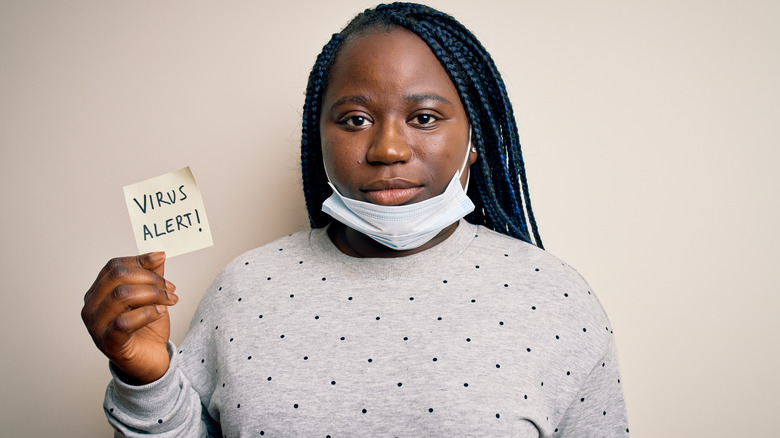Why The CDC Says The Percentage Of Americans Who Need To Mask Is On The Decline
Knowing when (and when not) to wear a mask can be a bit confusing, especially since wearing a face covering is on the decline. Two weeks ago, the amount of Americans who should highly consider masking up was approximately 82% (via U.S. News & World Report). But, now that number has dropped to 72%. Mask policies are changing, and pleasant late-summer weather means more outdoor gatherings, but does this explain why masking is on the decline? In a nutshell, yes and no.
On April 18 of this year, a judge dissolved the federal face mask requirements for commercial flights, public transportation, and transit hubs (per AARP). With mask orders easing in public places across states, cities, and counties, people are left up to their own devices to choose when to mask. "This is the hardest thing of all because it's not just the risks and benefits to you," said Dr. Robert Wachter, a professor at the University of California, San Francisco, to The New York Times. "It's the risks and benefits to the people around you."
Still one of the biggest explanations for the decline of masks may be attributed to the decline of COVID-19 cases and hospitalizations. According to U.S. News & World Report, cases in the U.S. have dropped from 130,000 new cases a day to 90,000 cases a day in just a month. This downturn could suggest that COVID-19 cases have reached their highest peak this summer as cases have started to decline.
Then when should you still wear a mask?
Even though coronavirus infections are decreasing across the U.S., wearing a face mask shouldn't be thrown completely out the window. Many counties are still suffering from high COVID-19 transmission rates. As reported by the Centers for Disease Control and Prevention (CDC), 91.19% of counties have high transmission rates, while 1.71% of counties have low transmission risk.
Based on the CDC's COVID-19 Community Levels map, 29.55% of Americans should consider masking up indoors, and 42.92% of Americans should think about using a face covering in public spaces based on their personal infection risk. In total, that's about 72% of the population. So, what's the best way to frame this issue — to mask or not to mask?
While the mask mandate is no longer in effect for public transportation, the CDC still recommends that people aged 2 and up wear masks in indoor public transportation areas. This includes trains, planes, and buses. You may also want to take into account the size of the indoor area; are there big ceilings, or is it crowded? High ceilings typically have great ventilation, and the risk of transmission tends to be lower, unless you're waiting in a crowded line, points out Linsey Marr, a Virginia Tech professor who researches the airborne transmission of viruses (via The New York Times). In addition, if you live, work, or travel with someone who is immunocompromised, continuing to wear a face covering, especially in indoor settings, is an excellent idea.


